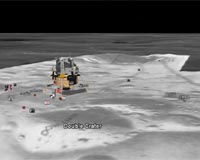 |
Bangalore, India (SPX) Jul 22, 2009 Chandrayaan-1, India's first mission to Moon, launched on October 22, 2008 from Satish Dhawan Space Centre, Sriharikota, has completed eight months of successful operation and has made 3,000 revolutions around the Moon. Besides sending more than 70,000 images of the lunar surface which provide breathtaking views of lunar mountains and craters, especially craters in the permanently shadowed areas of the Moon's polar region, Chandrayaan-1 spacecraft is also collecting valuable data pertaining to the chemical and mineral content of the Moon. Chandrayaan-1's orbit was raised from 100 km to 200 km circular on May 19, 2009. The high orbital altitude of Chandrayaan-1 reduces the resolution of the imagery but provides a wider swath and the data is of good quality. The onboard star sensor used for determining the orientation of the spacecraft started malfunctioning on April 26, 2009. To overcome this anomaly, ISRO devised an innovative technique of using redundant sensors - gyroscopes - along with antenna pointing information and images of specific location on the surface of the moon, for determining the orientation of the spacecraft. This method has been validated and based on this information, mission operations are being carried out satisfactorily. Other than the failure of the star sensor and one of the Bus Management Units, health of the spacecraft is normal. Recent review by scientists has confirmed that all primary mission objectives of Chandrayaan-1 have been successfully realised during the eight months of its operation. The spacecraft continues to send high quality data as per planned sequence to its ground station at Byalalu near Bangalore. Detailed review of the scientific objectives and the performance results on the Chandrayaan-1 mission is scheduled within three months after which further operational procedures will be worked out. It may be recalled that the primary mission of Chandrayaan-1 were: + To realise the complex spacecraft with 11 scientific instruments + To launch the spacecraft in near earth orbit and to carry out orbit raising manoeuvres of the spacecraft from 22,000 km to 3,84,000 km and place the spacecraft in a circular orbit around the moon + To place the Indian Tricolour on the moon + To carry out the imaging operation of the lunar surface and collect data on the mineral content of the lunar surface + To realise the deep space tracking network and implement the operational procedures for travel into deep space With the successful realisation of these objectives, additional data that will be derived during the remaining part of Chandrayaan-1's life will be complementary to already derived information. The data collected from Chandrayaan-1 instruments have been disseminated to the Indian scientists and also the partners from Europe and USA. The scientific community is extremely happy with the already obtained data and the results of analysis could be expected in about 6 months to 1 year period. Share This Article With Planet Earth
Related Links ISRO Mars News and Information at MarsDaily.com Lunar Dreams and more
 Google adds Moon to online Earth map service
Google adds Moon to online Earth map serviceSan Francisco (AFP) July 20, 2009 Google on Monday marked the 40th anniversary of the first human footsteps on the moon by adding virtual lunar exploration to its free online Earth map and imagery service. The moon joins Earth, Mars, and Sky in an options list in an upper tool bar on the main Web page at earth.google.com. Aspiring lunar explorers will need Google Earth 5.0 software, which can be downloaded free. ... read more |
|
| The content herein, unless otherwise known to be public domain, are Copyright 1995-2009 - SpaceDaily. AFP and UPI Wire Stories are copyright Agence France-Presse and United Press International. ESA Portal Reports are copyright European Space Agency. All NASA sourced material is public domain. Additional copyrights may apply in whole or part to other bona fide parties. Advertising does not imply endorsement,agreement or approval of any opinions, statements or information provided by SpaceDaily on any Web page published or hosted by SpaceDaily. Privacy Statement |